
Hydro energy may represent a form of clean, renewable energy, but the expansion of hydro in Guatemala has driven social conflict between the government, multinationals and the indigenous populations. In the process, it has reawakened old memories of the darkest days of the internal armed conflict, which tore Guatemala apart between 1960 and 1996.
Development of these projects has generated opposition from local indigenous communities, which in turn has triggered government-backed militarization of the area.
Since 2007, northern Huehuetenango, Guatemala, has been the site of aggressive hydroelectric power projects as transnational companies look to transform natural resources into privatized accumulation. These projects are part of a World Bank-supported campaign, known as Plan Mesoamerica, to create a common energy market that interconnects the infrastructures of all Central American countries.
These hydroelectric projects would allegedly lower the cost of electricity and combat Guatemala’s “energy poverty.” This plan, however, completely dismisses the voices and rights of local indigenous communities that would be most impacted by the intrusive expansion into their ancestral land.
Currently there are 15 projects in various stages of construction in the department of Huehuetenango, with four specifically along the Q’am’balam River, home to the Q’anjab’al, Choj and Akateko Mayan groups: Hidro Santa Cruz de Hidralia Natural, owned by a Spanish Firm in Santa Cruz Barillas; Hydro San Luis, owned by the company CM5, in Santa Eulalia; and Hydro Ixquisis, owned by the firm Promoción y Desarrollos Hídricos S.A. in San Mateo Ixtatán. Each project is being constructed as part of the Northern Development Zone, which creates the northern arch of electrical projects in Guatemala. The region also includes up to 22 permits for mining to Mexican mining firms.
The development of these projects has generated opposition from local indigenous communities, which in turn has triggered government-backed militarization of the area.
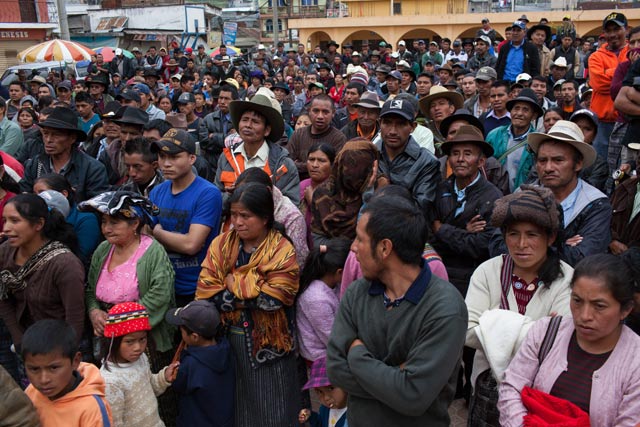 (Photo: Jeff Abbott)
(Photo: Jeff Abbott)
Plan Mesoamerica and Energy Interconnection
The modern expansion of privatized hydroelectric projects in Central America dates back to early 2000, after Mexican President Vicente Fox called for the integration of infrastructure of the countries of Central America. It was formally called Plan Puebla-Panama, but because of bad press and corruption, the plan was renamed Plan Mesoamerica in 2006.
“Guatemala has the highest number of springs and rivers, but the problem is that these rivers and waters are all in the territories of indigenous peoples, ones with a tradition of resistance.”
Negotiations for the plan commenced alongside the negotiations for the Central American Free Trade Agreement and came as part of the neoliberal project in the region. The plan looked to interconnect the telecommunications, electrical grids and roads throughout the region to assist in the free movement of goods and services.
Within Plan Mesoamerica, each country was assigned a specific development plan based on their perceived comparative advantage. Guatemala was given the task of producing energy for the region.
“No other country in Central America has the capability or potential for producing energy,” said Fernando Solis, during a presentation about the social impacts of another controversial project, the Xalala hydro electrical project in El Quiche. “Guatemala has the highest number of springs and rivers, but the problem is that these rivers and waters are all in the territories of indigenous peoples, ones with a tradition of resistance.”
Solis adds, “They (multinationals and government) plan to transform Guatemala into an energy exporter.”
The Central American Electrical Interconnection System (SIEPAC) then transfers the energy produced in Guatemala south.
The SIEPAC project has received promotion from both the World Band and The Inter-American Development Bank, with both banks making loans available for the formation of a Regional Energy Market (MER in the Spanish acronym). Loans have been made available through Inter-American Investment Corporation (ICC), a branch of the Inter-American Development Bank, and the Inter-American Corporation for Infrastructure Funding (CIFI).
“Historically there has been discrimination by the Ladinos against the Q’anjab’al and Mayan people.”
Specifically, the Inter-American Investment Corporation (ICC), a branch of the Inter-American Development Bank, has provided more than $13 million in financing for the project in San Mateo Ixtatán. The CIFI has made $10,000 available for the project in Barillas. The private sector is a key component of the construction of these projects.
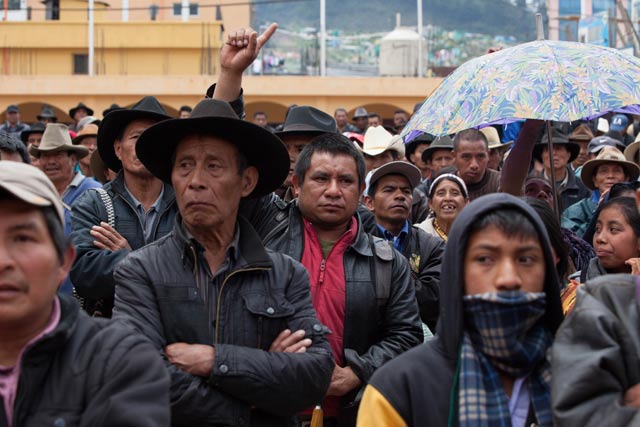 (Photo: Jeff Abbott)
(Photo: Jeff Abbott)
The Perpetuation of Structural Racism
Historically, the indigenous populations and the Guatemalan state have had an antagonistic relationship. The colonial structure had subordinated the indigenous peoples and transformed them into second-class citizens.
“Historically there has been discrimination by the Ladinos against the Q’anjab’al and Mayan people,” Jorge Ramirez, a community leader from Barillas, tells Truthout. “They think that they can do more, know more, etc. They think that the Mayans don’t exist; that we are only an object; that we don’t have any rights.”
In the case of the project in San Mateo Ixtatán, according to the impact assessment by the IIC, there are no indigenous populations affected by the project.
“The vast majority of the residents of the project area are Ladinos – Spanish-speaking Guatemalans who do not follow an indigenous life style,” the IIC writes in their assessment of the impacts of the project. “The project area communities do include some members of the (Q’anjab’al) and Chuj indigenous language groups, and these people are clustered in certain communities, however, there are no communities in the project area of influence that are monolingual or composed exclusively of any ethnic group.”
Yet according to statistics from the Guatemalan government, the majority of the residents in the region affected by the project are indigenous Q’anjab’al and Chuj. But by not recognizing the indigenous identity of the population, the business community and international banks perpetuate the structural racism that has plagued Guatemala since the arrival of the Spanish in 1524.
The communities have come to view the energy projects as yet another invasion of their territory.
Despite international conventions such as the International Labor Organization’s Convention 169 on the rights of indigenous peoples and provisions in the Guatemalan constitution, the communities have never been consulted by the government or by the companies working in the indigenous territories.
“The politics of the business, the transnational, is one that looks to exterminate the Mayan peoples,” Ramirez tells Truthout. “It is part of the politics of the state; locally, nationally, and globally. It is the false discourse of development.”
International Indigenous Rights and Resistance to “Projects of Death”
The opposition to the projects by the indigenous communities stymies the dispossession of sacred land. According to the communities, the projects threaten to flood the communal lands of the communities along the Q’am’balam River, as well as destroy their sacred sites.
In June 2007, the residents held a vote of the communities, with 46,481 people participating. At the end of the day, 46,472 voted no to any extractive projects, including mining, hydro or petroleum, in their territory.
The communities have organized peacefully to challenge the expansion of transnational companies into their territory. Since 2007, there have been over 50 peaceful marches calling for the end of the issuing of permits for projects in the region.
The communities have come to view the energy projects as yet another invasion of their territory. At the core of the conflict is the transformation by multinational companies and the Guatemalan government of the water and the natural resources of the territory of the Q’anjab’al Maya into a commodity.
“This is a struggle against capitalism,” Ramirez tells Truthout. “Capitalism is not compatible with the Mayan worldview. Development to them is access to grand projects, accumulation and the extraction of the resources of the communities. It doesn’t benefit and provide development for the (indigenous) peoples.”
“It is only for the benefit of global capital,” adds Ramirez. “These projects do not lower the cost of energy. They are simply a strategic part of a larger project of extraction of natural resources.”
A History of Resistance
Time and time again, the Guatemalan government and military, as well as the multinational companies operating in northern Huehuetenango, have violated the rights of the indigenous populations. But the communities have had a history of resistance and defense of territory.
The Q’anjab’al Mayan people, whose territory extends from the southern parts of Chiapas, Mexico, into the northern department of Huehuetenango in Guatemala, have struggled for centuries to protect their land and identity. According to Rigoberto Juárez, a Q’anjab’al Maya, a respected community leader, and coordinator of the Pluralnational government of northern Huehuetenango, the Q’anjab’al have faced five major invasions of their territory in the past 500 years.
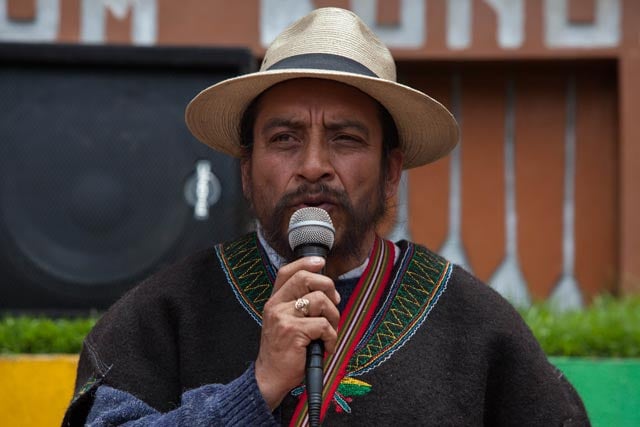 Rigoberto Juárez, a Community leader, coordinator for the Plural-National government of northern Huehuetenango and now political prisoner, addresses a crowd in Santa Eulalia, Huehuetenango. (Photo: Jeff Abbott)
Rigoberto Juárez, a Community leader, coordinator for the Plural-National government of northern Huehuetenango and now political prisoner, addresses a crowd in Santa Eulalia, Huehuetenango. (Photo: Jeff Abbott)
“Our people have a history of struggle,” Juárez told Truthout, weeks prior to his arrest. “There is no identity without struggle.”
For the community, and the Mayan communities in general, their identity and culture grow from the same soils that the maize comes from. For the Mayan communities across Mesoamerica, there is a sacred connection to the land, which represents part of the means for the reproduction of society.
“There is an old, deep, cosmological connection between the people and the land,” Ramirez tells Truthout. “The territory is the spring from where we come. To us, it represents a dignified life; one that is organic and based on harmony with the earth.”
The communities in resistance to the construction of hydroelectric projects in Q’anjab’al territory have faced violent repressions for their resistance.
The end of the 36-year-long internal armed conflict in 1996 brought one of the first opportunities in nearly 500 years for the indigenous peoples of Guatemala to recuperate their identities. Provisions in the peace accords – for the first time – recognized Guatemala as a multiethnic state and granted new rights to the indigenous populations. And in northern Huehuetenango, the Q’anjab’al Maya, who had been displaced by the war, began to return home.
“[After the war] we began recuperating the land and our identities,” Juárez told Truthout.
The communities were helped along in the recuperation of their identities by provisions within the peace accords. In 1997, Guatemala became a signatory of the International Labor Organizations Convention 169 on the rights of indigenous and tribal peoples, as well as the United Nation’s rights of indigenous peoples. Nationally, the Constitution granted new rights and recognized the importance of the territory of the indigenous populations.
It is in this atmosphere of peace that the new assault on the indigenous populations of Guatemala began.
Political Prisoners, Assassinations, Criminalization of Social Movements
The communities in resistance to the construction of hydroelectric projects in Q’anjab’al territory have faced violent repressions for their resistance.
“There is a clear process of criminalization of the leaders of the various social movements.”
Their situation reflects the dire and delicate situation indigenous rights and environmental activists face in Guatemala. According to Claudia Samayoa and data from United For the Protection of Defenders of Human Rights (UDEFUGUA), in 2014, aggression against those defending the environment represented 58 percent of all aggressions against human rights defenders.
This past March 25, Pascual Pablo Francisco, a community leader from Barillas in the Guatemalan department of Huehuetenango disappeared. Three days later, his body was found along a road, with signs of torture. Francisco had been an active member of the indigenous and community resistance in Santa Cruz Barillas.
Other community leaders too have been assassinated. Yet, according to Samayor, there has yet to be an investigation by the Guatemalan Public Ministries into the assassinations.
“There have been zero investigations into the assassinations of community leaders by the Public Ministry,” says Samayoa. “But there is a clear process of criminalization of the leaders of the various social movements.”
The Public Ministry has been involved in investigations in conflict zones, such as Barillas, but it has been involved in the investigation and prosecution of the leaders of the indigenous rights movements.
The same day that Pablo Francisco disappeared, Rigoberto Juárez was arrested along with Domingo Baltaraz for alleged crimes from December 2013. The two faced charges for allegedly threatening and illegally detaining workers from the site of the hydro project, as well as participating in the burning and destruction of machinery from the construction site in December 2013. Human rights observers challenge these accusations and point out that they are just the latest two to have been criminalized for their defense of territory.
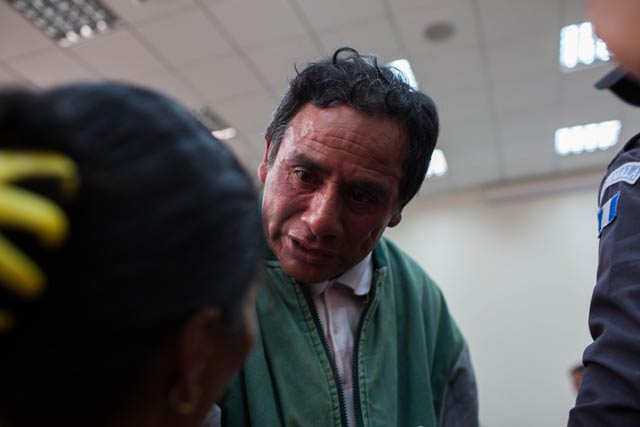 Domingo Baltazar, a community leader and political prisoner, addresses journalists and supporters after a preliminary court hearing – April 10, 2015. (Photo: Jeff Abbott)
Domingo Baltazar, a community leader and political prisoner, addresses journalists and supporters after a preliminary court hearing – April 10, 2015. (Photo: Jeff Abbott)
“There is a message being sent: If we can not have prisoners, then we are going to have dead.”
A judge ordered the release of Juárez and Baltazar three days after their arrest, pending further investigation by the Guatemalan Public Ministry. Despite accusations of their involvement, the Public Ministry, prosecutors and the accusers have yet to provide evidence of their involvement in the case.
But as Juárez and Baltazar were leaving the courthouse, they were arrested once again on new charges that had been filed two days prior. This time, they were being charged with “Kidnapping, Abduction and the intent to commit a crime.”
“How are we supposed to interpret this?” asked Samayoa. “The same day that Pablo Francisco is found dead, the other leaders who are released and then arrested again within minutes. There is a message being sent: If we can not have prisoners, then we are going to have dead.”
The case against Juárez and Baltazar reflect the criminalization of defenders of human rights in Guatemala, which has occurred in the past 4 years under the administration of president Otto Pérez Molina. The use of criminal charges is a means to exhaust and demoralize the leaders of the various movements.
“Rigoberto Juárez is clearly a prisoner of conscience,” said Saymayor. “But not just him, all those who are incarcerated from this conflict in Huehuetenango. They have been criminalized for the defense of their rights.”
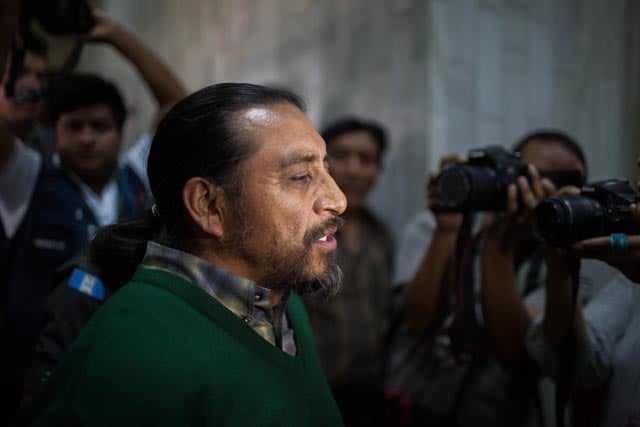 Rigoberto Juárez, a Community leader, coordinator for the Plural-National government of northern Huehuetenango and now political prisoner, addresses journalists after a preliminary court hearing – April 10, 2015. (Photo: Jeff Abbott)
Rigoberto Juárez, a Community leader, coordinator for the Plural-National government of northern Huehuetenango and now political prisoner, addresses journalists after a preliminary court hearing – April 10, 2015. (Photo: Jeff Abbott)
Juárez and Baltazar are not the only leaders detained in 2015; on February 26, Guatemalan national police arrested Professor Arturo Pablo, Adalberto Villatoro and Chico Palas. Like Juárez and Baltazar, the three were arrested on charges of “illegal detention, threats, the intention to commit a crime, and for elicit meetings and demonstrations.”
The violent repression has taken other forms, including the militarization of indigenous territory.
In May 2012, President Otto Pérez Molina declared a state of siege, suspending the constitution and deploying the military to Barillas. The state of siege lasted 18 days and led to the arrest of 19 leaders from the community and accusations of human rights violations by the military.
The conflict in northern Huehuetenango has reawakened the social conflict of the internal armed conflict. It has led to the reactivation of the dreaded paramilitary groups, the Civilian Patrol.
Many of the communities today that are struggling against the expansion of private investment into hydroelectric projects were the sites of massacres by the Guatemalan military.
During the 1980s, the Guatemalan military forced indigenous communities to participate in the paramilitary groups to fight the guerrilla insurgency. This forced inscription led to severe violations of human rights. Those who were accused of being “subversives,” were handed over to the military and disappeared.
The Civilian Patrols were a means of continuing the counterinsurgency within the indigenous communities in the conflict zones. Today, they are being utilized in a similar fashion, but this time as a means to protect the interests of the transnational companies.
“The members of the Civilian Patrols are operating alongside the military and the transnational companies,” Ramirez tells Truthout. “They were relaunched soon after the election of President Otto Pérez Molina and his Patriot’s Party. They are helping protect the interests of the business.”
The Continuation of the Military’s Development Plan
There is a living memory within the Q’anjab’al communities of the genocide that occurred during the internal armed conflict. Many of the communities today that are struggling against the expansion of private investment into hydroelectric projects were the sites of massacres by the Guatemalan military. It is these similarities to another conflict that has brought back memories of some of the darker episodes of the war.
Between 1981 and 1983, the Guatemalan military massacred the nearly 500 residents of the Achí Mayan communities, along the Chixoy River in the department of Alta Verapaz, to clear the way for the first expansion of hydro energy production in the region. The military justified the massacres by claiming that these communities were supporting guerrillas and thus part of the internal enemy, and as being part of the internal armed conflict. Those who survived the massacres were left in dire poverty and without a solution to the loss of their land.
The World Bank and Inter-American Development bank financed the project, all the while being aware of the human rights violations that were occurring during the project. After the project was finished, the banks guaranteed that an incident like Chixoy would never happen again.
Today, the case of Chixoy has remained a sore spot between the governments of Guatemala and the United States. Since the mid ’80s, the United States has continually made finding a solution for those affected by the construction of the Chixoy dam a requirement before reinstating full military aid to Guatemala.
The Departmental Assembly of Huehuetenango (ADH) wrote, “31 years later, the same methods are being repeated by Hidralia-Hidro Santa Cruz,” in a press statement in February 2014. “It is time to end the conflict created by the Spanish company in its attempt to implant two hydroelectric projects in the Q’am’balam River. The conflict has gone on for five years and has resulted in the persecution, intimidation and co-opting of community leaders. There have been assassinations, imprisonment; there is fear and terror.”
In 1982, during the height of the genocidal campaign by dictator Efrain Rios Montt, Huehuetenango was the site of the massacres of the indigenous peoples by the military. That year, the military killed more than 10,000 people, some 600 specifically in the municipalities of San Mateo Ixtacan and Santa Cruz Barillas; the indigenous communities have not forgotten these events.
“These are the same interests that were operating during the war,” Ramirez tells Truthout. “This has all been planned since the 1980s. It all began again with the signing of the peace accords. It may be in a slightly new form, but it is the same plan.”
Today this new form occurs in an era of globalization, with the Guatemalan government and military guaranteeing the rights of investment by multinational companies.
Where as the peace accords opened up new spaces for indigenous participation in Guatemala, today, the policies of the Guatemalan government have been steadily, once again, closing spaces to the indigenous. The Guatemalan government is carrying out a war against the indigenous populations by other means.
Some of the names in this piece have been changed to protect their identities.
Angry, shocked, overwhelmed? Take action: Support independent media.
We’ve borne witness to a chaotic first few months in Trump’s presidency.
Over the last months, each executive order has delivered shock and bewilderment — a core part of a strategy to make the right-wing turn feel inevitable and overwhelming. But, as organizer Sandra Avalos implored us to remember in Truthout last November, “Together, we are more powerful than Trump.”
Indeed, the Trump administration is pushing through executive orders, but — as we’ve reported at Truthout — many are in legal limbo and face court challenges from unions and civil rights groups. Efforts to quash anti-racist teaching and DEI programs are stalled by education faculty, staff, and students refusing to comply. And communities across the country are coming together to raise the alarm on ICE raids, inform neighbors of their civil rights, and protect each other in moving shows of solidarity.
It will be a long fight ahead. And as nonprofit movement media, Truthout plans to be there documenting and uplifting resistance.
As we undertake this life-sustaining work, we appeal for your support. Please, if you find value in what we do, join our community of sustainers by making a monthly or one-time gift.